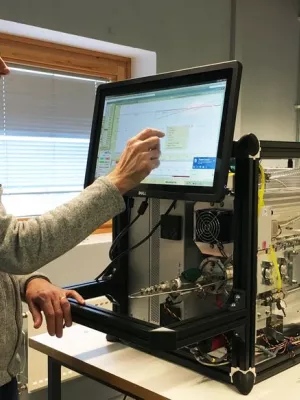
Erik Swietlicki
Professor

Phase partitioning of aerosol constituents in cloud based on single-particle and bulk analysis
Författare
Summary, in English
Single-particle analysis, performed by laser microprobe mass spectrometry and bulk analytical techniques were used to study aerosol-cloud interactions within the third field campaign of the EUROTRAC subproject 'ground-based cloud experiments' at the Great Dun Fell, Cumbria, U.K. in spring 1993. The shape of the ridge made it possible for ground-based instrumentation to sample similar parcels of air before, during and after their transit through the cloud. A single jet five-stage minicascade impactor was used for sampling particles of the interstitial aerosol. A second impactor worked in tandem with a counter-flow virtual impactor and collected residues of cloud droplets. Considering marine conditions largest droplets nucleated on sea-salt particles, whereas smaller droplets were formed on sulphate and methane sulphonate containing particles. This clearly indicates chemical inhomogeneities in the droplet phase. Particles, which were disfavoured by droplet formation, often contained the highest amounts of water-insoluble carbonaceous matter. For the submicron size range we found that the carbonaceous matter was always internally mixed with sulphate. The fraction of carbonaceous matter increased with decreasing size. A detectable fraction of particles remained in the cloud interstitial air, although they were in size as well as in composition suitable to form cloud droplets. The findings confirm that nucleation is the most important process affecting phase partitioning in cloud, but that spatial and temporal variations of water vapour supersaturation have also an influence on the observed phase partitioning. Proton induced X-ray emission analysis and light absorption measurements of filter samples showed that the average scavenged fraction was 0.77 for sulphur and 0.57 for soot in clouds formed by continental influenced air and 0.62 and 0.44, respectively, for marine influenced clouds.
Avdelning/ar
- Kärnfysik
Publiceringsår
1997-08-01
Språk
Engelska
Sidor
2491-2502
Publikation/Tidskrift/Serie
Atmospheric Environment
Volym
31
Issue
16
Dokumenttyp
Artikel i tidskrift
Förlag
Elsevier
Ämne
- Other Physics Topics
Nyckelord
- Cloud droplet residues
- Interstitial aerosol
- Laser microprobe mass spectrometry
- Nucleation scavenging
Status
Published
ISBN/ISSN/Övrigt
- ISSN: 1352-2310